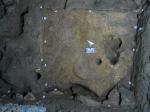Summary (English)
This short campaign aimed to investigate the deposit underlying US 4 in quadrant Q18, and retrace, beyond the sterile US 5, the underlying US 6. In 2016, the latter, in quadrant R 15, had produced evidence of very ancient human occupation, in the form of malaco-fauna, abundant charcoal, occasional remains of lithic industry and fragments of marine malaco-fauna belonging to bivalves and intact gastropods (_Bittium_ reticolatum). Recent radiometric dating of the charcoal gave a date of 23632±150 BP, the end of isotopic stage 3, in cultural terms a moment in the Gravettian period.
The nature of US 6 in this quadrant, constituted by a brown sandy-clay silt, containing abundant calcareous-travertine skeleton and small cobblestones of very uncertain provenance, had suggested the accumulation of surface water in this part of the cavern at some point. However, such an accumulation would have occurred to the detriment of the nearby archaeological level, removing the macro-fauna, charcoal, seashells, and lithic industry. This observation led to the need to investigate another quadrant situated 2 m away, in search of the same level but without the phenomena of surface runoff.The cleaning of the top of US 5 in quadrant Q 18 revealed the presence of residual patches of overlying US 4, whose colour and compactness were wrongly held to be part of US 5. The presence of a small amount of lithic industry and sparse charcoal confirmed the attribution of this context. In the central part of the quadrant, there was a post-hole with a conical longitudinal profile filled with residual US 4, which went down into underlying US 5. This confirmed, together with other evidence, the presence of probable shelters in the Epigravettian level. The removal of the residual patches of US 4 revealed a yellowish sandy clay sediment, which in effect corresponded with US 5 identified in other quadrants. However, during the excavation it was seen to be contaminated by elements from overlying US 4, such as charcoal, particularly in the zone close to section 2, where they probably formed two distinct layers, and scarce lithic industry (identified as from the top of US 5). It is likely that this was the initial phase of the Epigravettian occupation (US 4), corresponding with the date 13615±75 BP, or a slightly earlier date that may be verified with new radiometric dating.
At the end of this transition phase, the actual top of US 5 appeared, on which neither charcoal or lithic industry were present. The excavations halted here.
- Mauro Calattini- Dipartimento di Scienze Storiche e dei Beni Culturali – Università di Siena
- Attilio Galiberti- Dipartimento di Scienze Storiche e dei Beni Culturali – Università di Siena
Director
Team
- Attilio Galiberti
- Studenti del Dipartimento di Scienze Storiche e dei Beni Culturali e membri dell’Associazione Archeologica Piombinese
Research Body
Funding Body
- Università degli Studi di Siena






![Download [PDF]](/excavation/skins/fasti/images/results/download_sml.png)